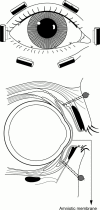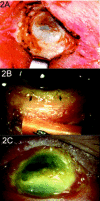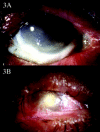Failure of amniotic membrane transplantation in the treatment of acute ocular burns
- PMID: 11520758
- PMCID: PMC1724102
- DOI: 10.1136/bjo.85.9.1065
Failure of amniotic membrane transplantation in the treatment of acute ocular burns
Abstract
Aim: To report the failure of amniotic membrane transplantation (AMT) for ocular surface reconstruction in patients with severe acute chemical and thermal burns.
Methods: Four eyes of three patients who suffered severe chemical (n=3) and thermal (n=1) burns were studied. The aim of AMT was to prevent symblepharon formation, promote conjunctival regeneration, inhibit corneal melting by promoting epithelialisation, and to protect the ocular surface while associated lid burns were treated. AMT was used to cover the entire ocular surface of all the severely burnt and ischaemic eyes, 2-3 weeks after the injury. Where indicated, AMT was repeated by itself or in combination with other procedures in all patients.
Results: Three of the four eyes developed symblepharon and progressive corneal melt requiring urgent tectonic keratoplasty. All four eyes had persistent epithelial defects. Less than 25% of conjunctival regeneration occurred in three eyes. Two eyes autoeviscerated, one patient underwent lid sparing exenteration for a painful blind eye and one eye became phthysical.
Conclusions: AMT did not help to restore the ocular surface or preserve the integrity of the eye in all our patients with severe acute burns, when used by itself or in combination with other surgical procedures. This reflects the extreme severity of the ocular burns in these patients and, in turn, draws attention to the fact that the current classification system does not adequately reflect such severity. In the current system such burns would be grouped under grade IV injuries to the eye (more than 50% limbal ischaemia). The prognosis of patients with 100% limbal ischaemia is much worse than patients with just over 50% limbal ischaemia. This inadequacy of the classification system probably also explains the difference between outcomes of management of grade IV burns (with AMT) in this series, compared with others.
Figures



Comment in
-
Failure of amniotic membrane transplantation in the treatment of acute ocular burns.Br J Ophthalmol. 2002 Jul;86(7):831. doi: 10.1136/bjo.86.7.831. Br J Ophthalmol. 2002. PMID: 12084765 Free PMC article. No abstract available.
References
Publication types
MeSH terms
LinkOut - more resources
Full Text Sources
